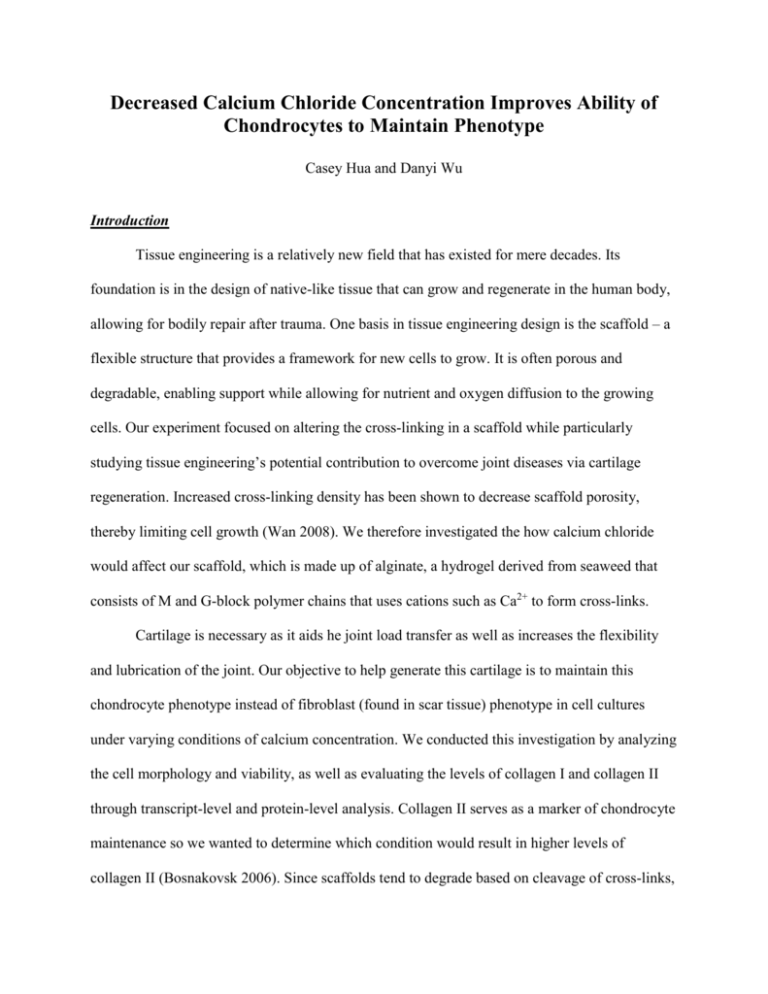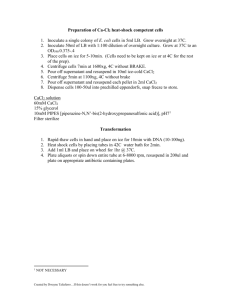Module_3_Report+Figures-
advertisement

Decreased Calcium Chloride Concentration Improves Ability of Chondrocytes to Maintain Phenotype Casey Hua and Danyi Wu Introduction Tissue engineering is a relatively new field that has existed for mere decades. Its foundation is in the design of native-like tissue that can grow and regenerate in the human body, allowing for bodily repair after trauma. One basis in tissue engineering design is the scaffold – a flexible structure that provides a framework for new cells to grow. It is often porous and degradable, enabling support while allowing for nutrient and oxygen diffusion to the growing cells. Our experiment focused on altering the cross-linking in a scaffold while particularly studying tissue engineering’s potential contribution to overcome joint diseases via cartilage regeneration. Increased cross-linking density has been shown to decrease scaffold porosity, thereby limiting cell growth (Wan 2008). We therefore investigated the how calcium chloride would affect our scaffold, which is made up of alginate, a hydrogel derived from seaweed that consists of M and G-block polymer chains that uses cations such as Ca2+ to form cross-links. Cartilage is necessary as it aids he joint load transfer as well as increases the flexibility and lubrication of the joint. Our objective to help generate this cartilage is to maintain this chondrocyte phenotype instead of fibroblast (found in scar tissue) phenotype in cell cultures under varying conditions of calcium concentration. We conducted this investigation by analyzing the cell morphology and viability, as well as evaluating the levels of collagen I and collagen II through transcript-level and protein-level analysis. Collagen II serves as a marker of chondrocyte maintenance so we wanted to determine which condition would result in higher levels of collagen II (Bosnakovsk 2006). Since scaffolds tend to degrade based on cleavage of cross-links, we hypothesized that a lower CaCl2 concentration added to the cell cultures would create less cross-links, making the scaffold more easily degradable and more porous, which will help maintain chondrocyte phenotype. Results Since we wanted to investigate the effects of Ca2+ on the alginate scaffold and chondrocyte maintenance, we used alginate gel from Protanal LF 10/60 due to its high G/M ratio (~70/30), as only the G blocks cross-link. We seeded our cultures at a cell density of 5 x 106 cells/mL before growing our cells for a twelve day span under two conditions: 102 mM CaCl2 and 510 mM CaCl2. To confirm whether or not our culture conditions were effectively able to maintain the cells’ chondrocyte phenotypes, we performed transcript-level analysis via RT-PCR and protein-level analysis using an ELISA to obtain quantitative data about the collagen content, and observed cell morphology and viability to determine cell phenotype qualitatively. After seven days of growth, we attempted to observe our cells under fluorescence microscopy by performing a Live/Dead fluorescence assay and viewing the cells under a fluorescent microscope. We did not obtain a clear image to determine our cells’ viability, however, perhaps due to light from the room interfering with the clarity of the photograph. Despite this, we did observe under the microscope that cells under the 102 mM CaCl2 condition fluoresced green (indicating live cells), whereas cells grown at 510 mM CaCl2 tended to cluster into colonies and had a few red spots among the green under the microscope (indicating some dead cells among the mostly live cells). Quantitative data about whether the cells were producing collagen II, a key ingredient in cartilage, was obtained through transcript-level analysis via RT-PCR and gel electrophoresis and protein-level analysis from an ELISA. RNA products produced from cell lysates used for these procedures were acquired after twelve days of chondrocyte growth. To determine the purity of these collected RNA samples, their absorbencies were measured at A260 and A280 in the spectrophotometer. Both the 102 mM and 510 mM CaCl2 samples had A260/A280 ratios of exactly 2 (0.004/0.002 and 0.006/0.003 respectively), which signified that the RNA used for the RT-PCR sand ELISA were extremely pure. Figure 1 illustrates the gel produced from the RTPCR, with the amplified cDNA that was reverse transcribed from the RNA that was grown under different concentrations of CaCl2 with different collagen primers (CNI and CNII). GAPDH, a housekeeping gene, was used as an internal control to compare the four samples, and appears as the lower band in all lanes. Using ImageJ software, we were able to determine band intensities and normalize the collagen samples to GAPDH. Although the ratios from the band intensities in the collagen I samples did not show a statistically significant change, Figure 1B shows that the 102 mM CaCl2 resulted in a much higher collagen II expression (3.402) than the 510 mM CaCl2 sample (0.924). Another assay performed was the ELISA, in which we used to determine the actual concentrations of collagen within the samples. Figure 2 illustrates that although collagen I was expressed in relatively large quantities, it was also relatively equal under both conditions (41.9 ng/mL and 39.6 ng/mL respectively). However, only collagen II appeared to be expressed in the 102 mM CaCl2 sample (10.3 ng/mL), but not the 510 mM CaCl2 condition (0 ng/mL). One factor to note though, was that in order to achieve a high r2 value (both greater than 0.99) for the calibration curves for the standards, the top few values were not included in the calculation. This was due to saturation of the absorbance levels of those particular ELISA samples, which greatly altered the calibration. Although these data points were not used, the concentrations of protein that acted as standards were well and above the amount we obtained from our samples, so all our data fell within the range of data we used, demonstrating a dependability of the data for our collagen concentrations. Discussion Tissue engineering of cartilage may be an effective and valuable method of regenerating the cartilage that is affected in joint diseases such as osteoarthritis. We hypothesized and found that under the lower concentration of CaCl2, chondrocyte phenotype was maintained more effectively than under a condition of higher concentration of CaCl2. Our quantitative data demonstrated more collagen II is in the 102 mM CaCl2 concentration sample in comparison to the 510 mM concentration. However, there are several improvements that can be made to our experiments that would further expand the investigation and the reliability of the data. For example, more trials can be conducted per calcium concentration to develop a consistency among the samples and data. More concentrations of calcium can also be studied, as they would reveal a more accurate trend of how the collagen II is correlated with the calcium concentrations. By extending the length of time for when our chondrocyte cells are growing, we may be able to obtain more RNA and protein that would provide more data than the minute amounts that we determined from our ELISA. Future experiments may revolve around the in vivo aspect of using this technique as a viable application for regenerating cartilage tissue. Since the scaffold’s cross-links affects the degradability of the scaffold, which is based upon the cleavage of cross-links, future investigations may analyze how much the varying calcium concentrations actually affect the cross-linking – whether it is making the scaffold stronger and tighter, or more flexible and less rigid. Studying how this scaffold would degrade in the joint may demonstrate how the cells will within the body. Another factor to look into is the biocompatibility of using these calcium concentrations for chondrocyte maintenance. Certain levels of calcium are toxic to the body, so an optimal range of calcium concentrations must be determined that has both efficacy and low toxicity. Thus, further assessment of the effects of calcium concentration on chondrocyte phenotype maintenance may have important in vivo implications as well. References Wan, 2008: http://www.springerlink.com/content/g6r10wh512843027/ Bosnakovsk, 2004: given in class Ladder 102 mM CaCl2 510 mM CaCl2 102 mM CaCl2 510 mM CaCl2 CNI CNI CNII CNII A B Effects of [Calcium] on Collagen I/II Transcript Production 4.000 Normalized Expression 3.500 3.000 2.500 102 mM CaCl2 510mM CaCl2 2.000 1.500 1.000 0.500 0.000 Collagen I Collagen II Figure 1. Effects Of Calcium Concentration On Collagen I/II Transcript Production, As Measured By RTPCR. RT-PCR was carried out to create cDNA from cell lysate mRNA and to amplify the cDNA of interest, either Collagen I (CNI) or Collagen II (CNII). GAPDH (lower band in all lanes) was used as an internal standard used for normalization of collagen expression. (A) cDNA created from samples of cells cultured in alginate with 102mM CaCl2 and 510mM CaCl2 was run through an agarose gel, along with a standard ladder, to measure relative expression of Collagen I and Collagen II in each sample. (B) ImageJ analysis of band intensities on agarose gel reveal normalized expression levels of: 102mM CaCl2—CNI 3.093, CNII 3.402, and 510mM CaCl2—CNI:2.771, CNII 0.924. Effects of [Calcium] on [Collagen I/II] Protein Production 45 40 [Collagen] (ng/mL) 35 30 25 102mM CaCl2 510mM CaCl2 20 15 10 5 0 Collagen I Collagen II Figure 2. Effects Of Calcium Concentration On Collagen I/II Protein Production, As Measured Through ELISA. Alginate beads from each sample, one sample containing alginate made with 102mM CaCl2 and another with 510mM CaCl2, were dissolved and assessed for Collagen I/Collagen II protein concentration through an indirect ELISA assay. Collagen protein concentrations were measured as follows: 102mM CaCl2—CNI 41.9ng/mL, CNII 10.3ng/mL, and 510mM CaCl2—CNI 39.6ng/mL, CNII 0.0ng/mL.






